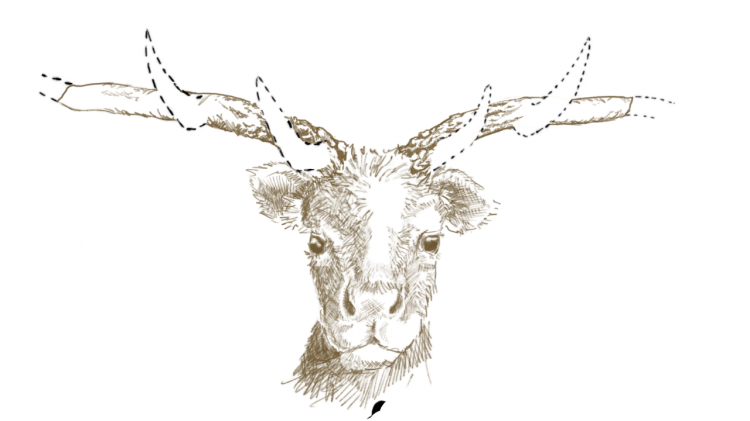Across millennia, animals have evolved, adapted, and sometimes disappeared in response to environmental change. Today, those pressures are shaping related species in different ways. The deer family (cervids) populations are showing strikingly different trends: caribou and moose are declining, elk and mule deer are more-or-less stable, while white-tailed are growing.

Sketch of the Toronto subway deer, Torontoceros, by Sherri Owen
Understanding the flow of genetic diversity through deer populations over time is at the centre of new research to be published in Biology Letters by Dr. Aaron Shafer, chair of Forensic Science at Trent and Dr. Camille Kessler, a graduate of Trent's Environmental & Life Sciences Ph.D. program.
"We can use genomics to understand the history of these deer species in Canada, four of which are in Ontario. By comparing ancient and modern genetic data, we can see how species evolve in their natural environments and how forces may have shaped or will shape their health or resilience," says Professor Shafer. "When we look at the woolly mammoth, for instance, its DNA showed that the population accumulated a lot of harmful mutations over time. Then, as climate and habitat shifted, the last population was pushed onto an island, and both of those factors ultimately led to its extinction."
The Lore of the Toronto Subway Deer
To explore how deer species today might be following similar patterns, Prof. Shafer and Dr. Kessler analyzed about 50 samples from ancient cervid ancestors deer, elk, moose, and caribou from the Royal Ontario Museum (ROM) and the Royal Alberta Museum.
They were able to extract ancient DNA from about 25 percent of samples, including from a uniquely shaped antler that was discovered by a Toronto Transit Commission worker in the city's west end in 1976. Scientists couldn't match the antler's thick, horizontal beams to any known species. Paleontologists named it Torontoceros hypogaeus, meaning "horned Toronto deer from underground," but it was more commonly called the Toronto Subway Deer. Debate over the animal's closest relatives has continued for five decades.
From Fossil to Genetic Code
With DNA analysis coming a long way since the 70s, including better techniques for extracting DNA from ancient remains, Prof. Shafer and Dr. Kessler were able to shed light on the species. Through DNA analysis at the ROM's ancient DNA lab, along with the museum's collections technician and researcher, Oliver Haddrath, the research team revealed that the antler belonged to an extinct species of deer, more closely related to white-tailed and mule deer than to caribou.
"By comparing short strands of the animal's DNA across species, we could see it diverged before white-tailed deer and mule deer think of it as their grandparent," explains Prof. Shafer. "It's an exciting finding but you're always tempering your excitement until you're confident in your screening for contamination and degradation in ancient DNA samples. Watching Camille move through every step of scientific review and validation was incredible."
Echoes of an Ancient Extinction
The discovery fits within the broader picture of a megafaunal extinction event about 12,000 years ago, when many large mammals failed to adapt to rapid climate change. Now, with ancient DNA revealing another extinct species' identity and genetic signatures related to modern day deer species and populations, Prof. Shafer's team is exploring what these findings might tell us about resilience, and vulnerability, in wildlife facing environmental change today.
Read this story in the New York Times and the Globe and Mail.
Learn more about Forensic Science and Environmental & Life Sciences at Trent University.











